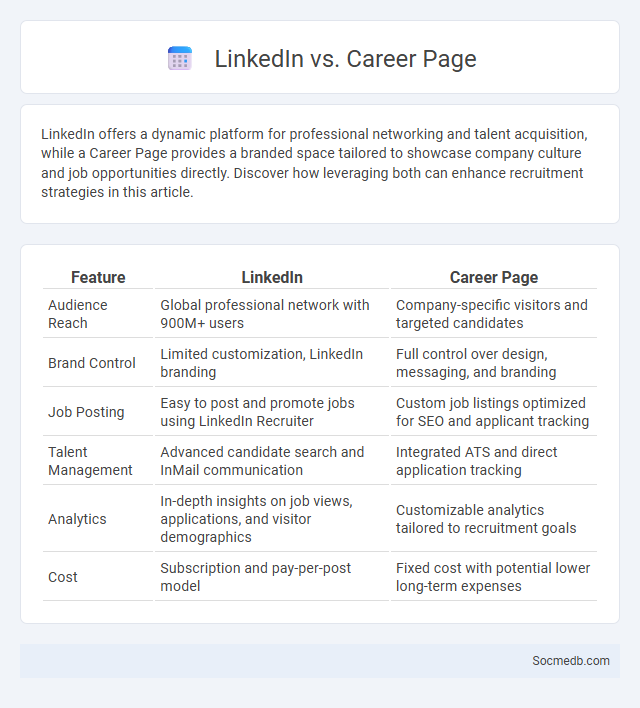
Photo illustration: LinkedIn vs Career Page
LinkedIn offers a dynamic platform for professional networking and talent acquisition, while a Career Page provides a branded space tailored to showcase company culture and job opportunities directly. Discover how leveraging both can enhance recruitment strategies in this article.
Table of Comparison
| Feature | Career Page | |
|---|---|---|
| Audience Reach | Global professional network with 900M+ users | Company-specific visitors and targeted candidates |
| Brand Control | Limited customization, LinkedIn branding | Full control over design, messaging, and branding |
| Job Posting | Easy to post and promote jobs using LinkedIn Recruiter | Custom job listings optimized for SEO and applicant tracking |
| Talent Management | Advanced candidate search and InMail communication | Integrated ATS and direct application tracking |
| Analytics | In-depth insights on job views, applications, and visitor demographics | Customizable analytics tailored to recruitment goals |
| Cost | Subscription and pay-per-post model | Fixed cost with potential lower long-term expenses |
Introduction to Talent Acquisition Channels
Talent acquisition channels encompass various platforms and methods used by organizations to attract and recruit qualified candidates efficiently. Social media platforms such as LinkedIn, Facebook, and Twitter serve as essential channels, allowing recruiters to engage with potential talent, showcase company culture, and post job openings. Leveraging social media analytics and targeted advertisements enhances the precision of talent acquisition strategies, improving candidate quality and recruitment speed.
Understanding LinkedIn as a Recruiting Tool
LinkedIn serves as a powerful recruiting tool by providing access to a vast network of professionals across various industries and experience levels. You can leverage advanced search filters and AI-driven recommendations to identify and engage top talent efficiently. Optimizing your LinkedIn presence improves candidate quality and accelerates hiring processes, making recruitment more targeted and data-driven.
The Role of Company Career Pages
Company career pages play a crucial role in shaping your employer brand by providing detailed insights into corporate culture, job opportunities, and employee experiences. These pages act as centralized platforms for sharing authentic content, such as employee testimonials, benefits, and company values, driving organic engagement on social media channels. Optimizing your career page for SEO and integrating social sharing buttons enhances visibility, attracting high-quality talent through targeted social media campaigns.
Defining Employer Branding in Recruitment
Employer branding in recruitment represents the perception and reputation of a company as an employer, shaped through consistent messaging on social media platforms. You can effectively attract top talent by showcasing your organization's culture, values, and employee experiences online. Leveraging authentic content and engagement on channels like LinkedIn, Instagram, and Twitter enhances your recruitment efforts and positions your brand as an employer of choice.
LinkedIn vs Career Page: Reach and Engagement
LinkedIn offers unparalleled reach with over 900 million users worldwide, making it a prime platform for professional networking and job opportunities. Career pages on company websites provide highly targeted engagement by attracting candidates already interested in the brand, resulting in quality applications. While LinkedIn drives broader visibility and active talent sourcing, career pages excel in deepening candidate-brand connection and fostering sustained engagement.
Employer Branding Impact on Candidate Attraction
Social media platforms significantly enhance employer branding by showcasing company culture, values, and employee experiences, which attracts top talent. Consistent and authentic social media presence increases candidate engagement and improves recruitment metrics such as application rates and quality of hires. Leveraging LinkedIn, Instagram, and Glassdoor effectively drives positive perception, making organizations more appealing to prospective employees.
Cost Comparison: LinkedIn, Career Page, and Branding
LinkedIn offers targeted professional reach with premium plans ranging from $29.99 to $119.95 per month, optimizing recruitment and branding efforts. Career Pages on company websites incur varying development and maintenance costs but provide full control over employer branding and candidate experience. Branding across social media platforms requires budget allocation for content creation, advertising, and analytics, with costs fluctuating based on campaign scope and audience targeting precision.
Candidate Experience Across Different Platforms
Social media platforms like LinkedIn, Twitter, and Facebook shape your candidate experience by offering unique engagement tools and communication styles that influence recruitment outcomes. Tailoring your application approach to each platform's culture and features enhances visibility and interaction with potential employers. Understanding platform-specific expectations ensures a seamless and positive candidate experience, increasing the likelihood of job offer success.
Integrating LinkedIn, Career Page, and Employer Branding
Integrating LinkedIn with your Career Page enhances employer branding by showcasing company culture, employee testimonials, and job openings in a cohesive digital presence. Leveraging LinkedIn's professional network drives targeted traffic to your Career Page, increasing the quality of applicants and engagement rates. Your brand's visibility is amplified as consistent messaging across platforms builds trust and attracts top talent.
Conclusion: Choosing the Right Recruitment Strategy
Selecting the right recruitment strategy on social media involves targeting platforms where the ideal candidates are most active, such as LinkedIn for professionals or Instagram for creative roles. Tailoring content to match each platform's unique user behavior increases engagement and attracts qualified applicants. A data-driven approach, analyzing metrics like click-through rates and application quality, ensures ongoing optimization of recruitment efforts.
 socmedb.com
socmedb.com